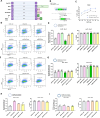Engineering tripartite gene editing machinery for highly efficient non-viral targeted genome integration
- PMID: 40379664
- PMCID: PMC12084546
- DOI: 10.1038/s41467-025-59790-3
Engineering tripartite gene editing machinery for highly efficient non-viral targeted genome integration
Abstract
Non-viral DNA donor templates are commonly used for targeted genomic integration via homologous recombination (HR), with efficiency improved by CRISPR/Cas9 technology. Circular single-stranded DNA (cssDNA) has been used as a genome engineering catalyst (GATALYST) for efficient and safe gene knock-in. Here, we introduce enGager, an enhanced GATALYST associated genome editor system that increases transgene integration efficiency by tethering cssDNA donors to nuclear-localized Cas9 fused with single-stranded DNA binding peptide motifs. This approach further improves targeted integration and expression of reporter genes at multiple genomic loci in various cell types, showing up to 6-fold higher efficiency compared to unfused Cas9, especially for large transgenes in primary cells. Notably, enGager enables efficient integration of a chimeric antigen receptor (CAR) transgene in 33% of primary human T cells, enhancing anti-tumor functionality. This 'tripartite editor with ssDNA optimized genome engineering (TESOGENASE) offers a safer, more efficient alternative to viral vectors for therapeutic gene modification.
© 2025. The Author(s).
Conflict of interest statement
Competing interests: I.M., J.W., J.S., D.L., K.X., R.S. and H.W. are paid employees from Full Circles Therapeutics, R.S. is founder and shareholder of Quintara Bioscience, Inc. Provisional patent “DNA EDITING CONSTRUCTS AND METHODS USING THE SAME” related to this study have been filed by Hao Wu and Richard Shan with Patent Application No. 63/427,370, on November 22, 2022. The remaining authors declare no competing interests.
Figures






Update of
-
Engineering Tripartite Gene Editing Machinery for Highly Efficient Non-Viral Targeted Genome Integration.Res Sq [Preprint]. 2023 Oct 23:rs.3.rs-3365585. doi: 10.21203/rs.3.rs-3365585/v1. Res Sq. 2023. Update in: Nat Commun. 2025 May 16;16(1):4569. doi: 10.1038/s41467-025-59790-3. PMID: 37961210 Free PMC article. Updated. Preprint.
References
-
- Doudna, J. A. & Charpentier, E. The new frontier of genome engineering with CRISPR-Cas9. Science346, 1258096 (2014). - PubMed
MeSH terms
Substances
Grants and funding
LinkOut - more resources
Full Text Sources

